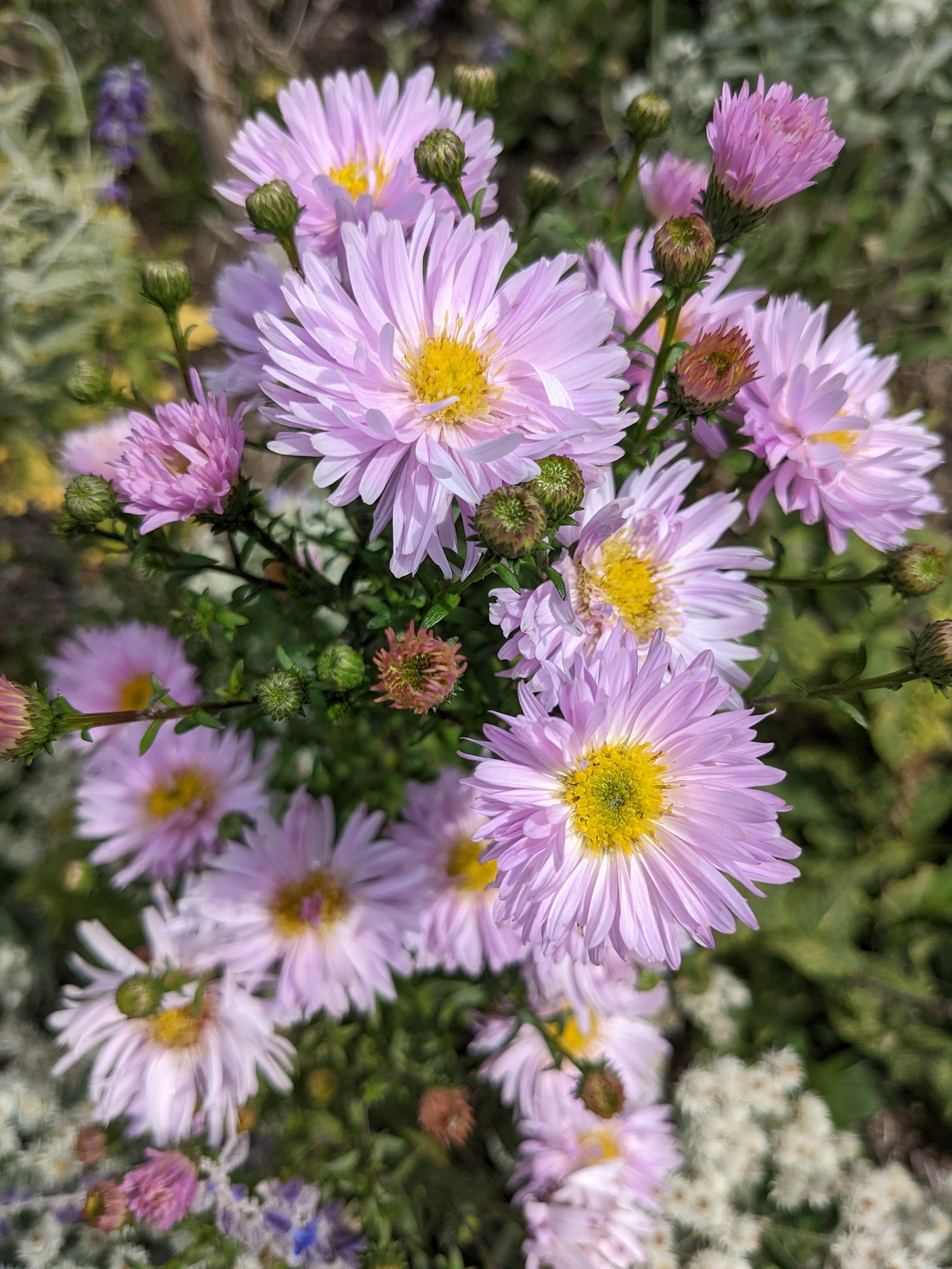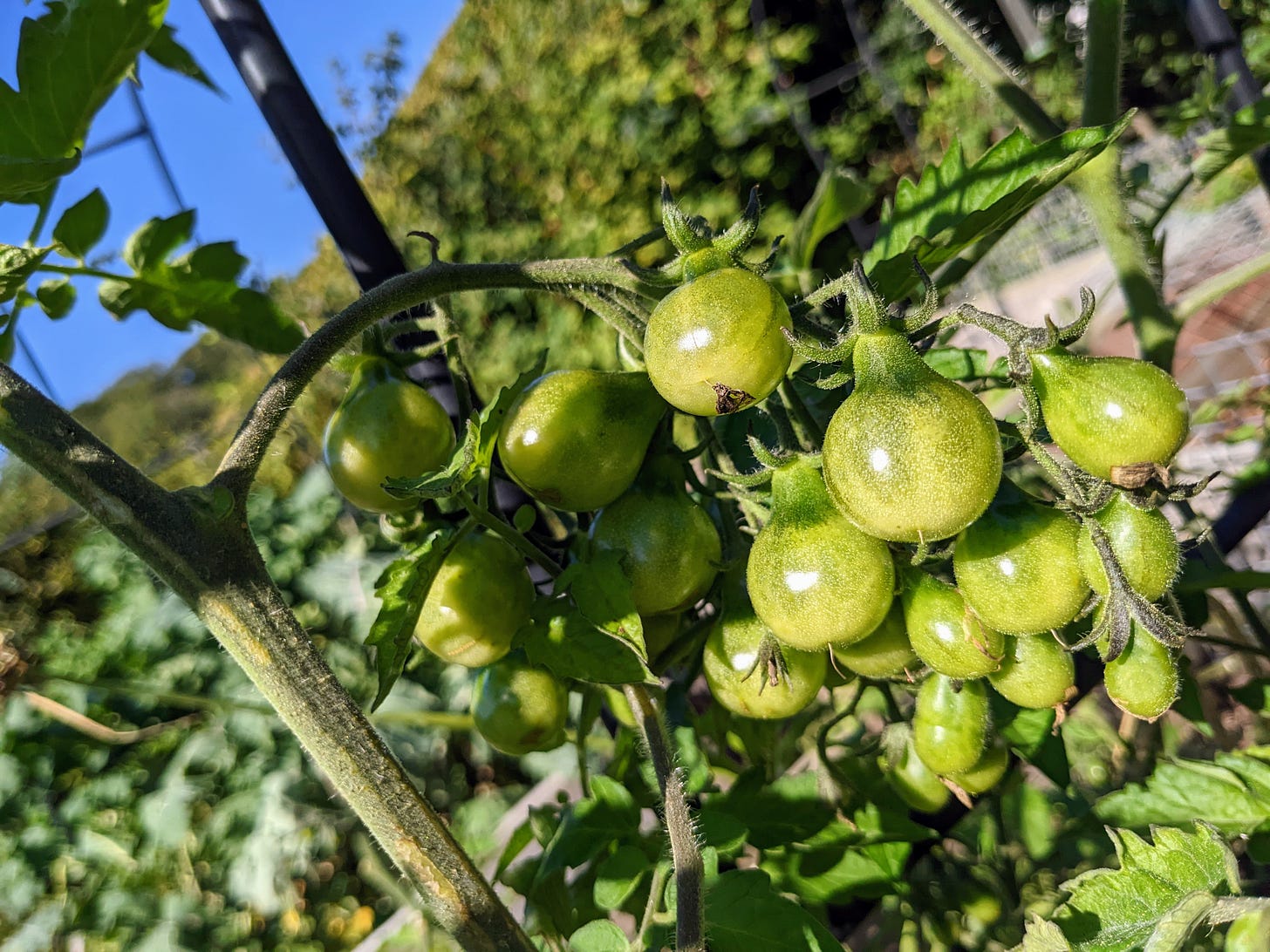In this issue:
What’s growing this month: bringing in the harvest
From the garden office: what do growing tomatoes and writing novels have in common?
Greenhouse guest: From bluebells to bladderwrack – a Scottish seaside adventure with children’s author Justin Davies
What’s growing this month
Hello friends. It’s been a whole season since I last wrote. There were Reasons, including my first tango with lady ‘rona. Unfortunately, I did not get the ‘few days of sniffles’ version of covid. I was floored for weeks, and I’m still clawing back energy. I shudder to think what it would have been like if I wasn’t vaccinated. If you are also struggling, solidarity—I hope you can take many naps.
While I was convalescing, the garden ripened into autumn—flowering and fruiting and sequestering the fading light. September began harvest season. Peaches and pears were the first trees in my urban orchard to bear fruit. Many of my young apple trees are still busy growing branches rather than stubby fruiting spurs, but I have high hopes for next year.
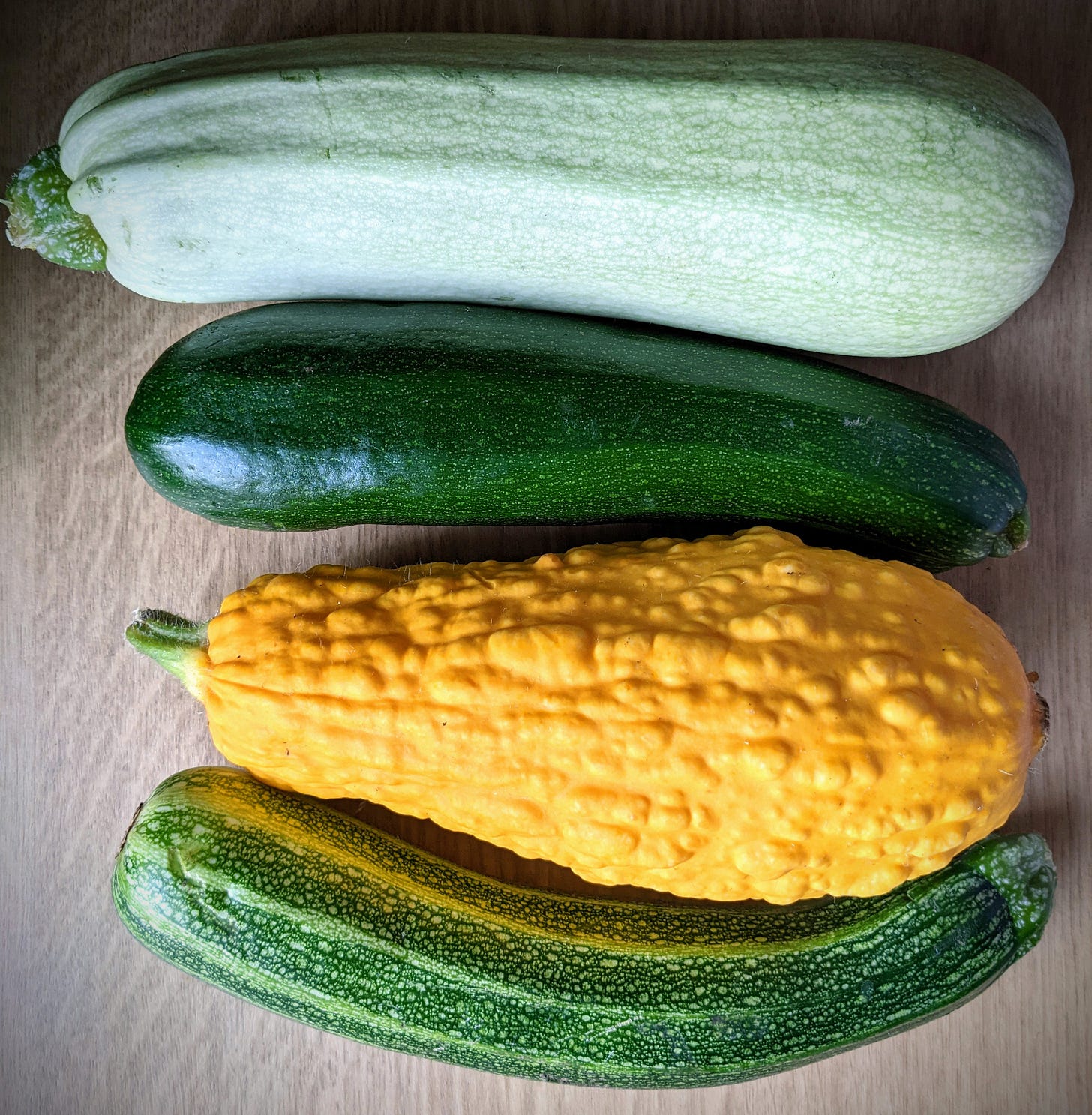
The summer veg also reached its crescendo in September. Up came the garlic, laid out to dry and braided for storage. I ran out of ideas for cooking courgettes and started pickling, fermenting, and preserving for the chilliest and darkest days. The summer raspberries passed the baton to their golden autumn counterparts. I ate them straight from the canes—there’s nothing like truly fresh berries. There were tomatoes, too, but more about that later.
October was a month of wild harvest. Along the verges, rosehips shone like early Christmas baubles, brambles offered up their bounty, and sea buckthorn bejeweled the foreshore (these gems make a syrup that’s a super source of Vitamin C).
Most blooms began to fade from the garden. I treasured the heroes of late autumn: aster and clematis, determined snapdragons, and some electric purple dahlias doing their darndest until the first frost. The beloved climbing rose I inherited isn’t unknown to give us its last bloom in January, and the hesperantha, if I’m lucky, will continue at least until the solstice.
But my work now turns to putting the garden to bed for the winter. More about that next time…
From the garden office: nothing is ever wasted
Amid all that talk of harvest, you might have the impression that everything went well. The truth is, in the veg patch, there were probably just as many failed experiments as there were successes. I’m still learning about this (ever changing) microclimate, and I’ll also be the first to admit I’m better with flowers than vegetables (so far!).
Why? Veg growing is hugely rewarding, but there are many challenges to contend with—voracious slugs, aphids, unexpectedly late cold-snaps. Enemies arrive on a smaller scale, too. Ask any grow-your-own tomato enthusiast in the UK what keeps them awake at night in harvest season, and I bet they give you a one-word answer: blight.
Tomato and potato blight can take a thriving plant and, within the space of just a couple of days, turn it, and its fruit, to soggy brown mush. Two days. Seriously. This is not hyperbole. The trick is to keep your eye out… once you see that first leaf hanging limp and drab, you pounce.
Still, it’s devastating.
You might think: they’re just tomatoes, Pete. Yes. And no. Sure, they’re comparatively small specimens in the plant world, and aren’t hugely expensive in financial terms. Instead, what they represent is investment of time, care, and the hope your efforts bear fruit. A lot of people won’t understand why you spend so much time nurturing something you can buy in the store or at the farmer’s market. Just like a lot of people won’t understand why us writers spend so much time scribbling about imaginary people.
In my part of Scotland, I sow tomatoes in February in a propagator indoors. Once they have their first pair of true leaves, they get transplanted into individual small pots. About 6-8 weeks later, I’ll upsize their containers (still under glass). At the end of May, when the final (we hope) frosts have passed in my neck of the woods, they can get planted out in the garden. The bulk of the fruit ripens in September or October. Seven or eight months have passed from seed to harvest.
This year, blight found the outdoor plants in mid-September. All the fruit was still green. I picked them before rot set in, and made one of my favourite things: salsa verde. It wasn’t what I’d planned, but my efforts weren’t completely wasted. In fact, I’m having delicious green chili enchiladas tonight. Nom.
Still, the whole process reminds me of the act of faith that is long-form writing. Even my most prolific author friends will take several months for a first draft. Then there’s the editing and polishing to do. And no matter how much diligent time you take, how much love and care you give that manuscript, there’s often no guarantee it won’t get book-blight and not find a home with an agent or traditional publisher.
On occasion, I still have moments of sheer terror at the thought of dedicating months to something that may never bear fruit. At best, it’s a daunting prospect. At worst, immobilising. It's only at this point in my career, where I’ve had plenty of ideas I couldn’t make work, that I’m able to remind myself when the fear sets in that there is a comforting truth in writing: nothing is ever wasted.
What do I mean? Well, I’m about to start development on a project I’m super excited about. It takes the heart of a manuscript I only ever showed to one person, mashes it up with some obsolete worldbuilding from a more recent project, and gives it a shiny new narrative engine from a completely different genre. Back when I wrote the secret manuscript, I didn’t have the craft and tools I’ve acquired since. I needed to go through the process, failed harvests and all.
In the garden, we might not end up with the shiny red fruit we’d been looking forward to all year. But gosh, green tomato hot sauce is pretty great. When I get the fear of book blight, I try to remember that even if the seeds of this story don’t flourish, they may find fertile ground in the next. I write because I love to grow stories. I garden because I love plants.
I never know what next year’s harvest will bring… and yet I’ve just ordered 2023’s seeds.
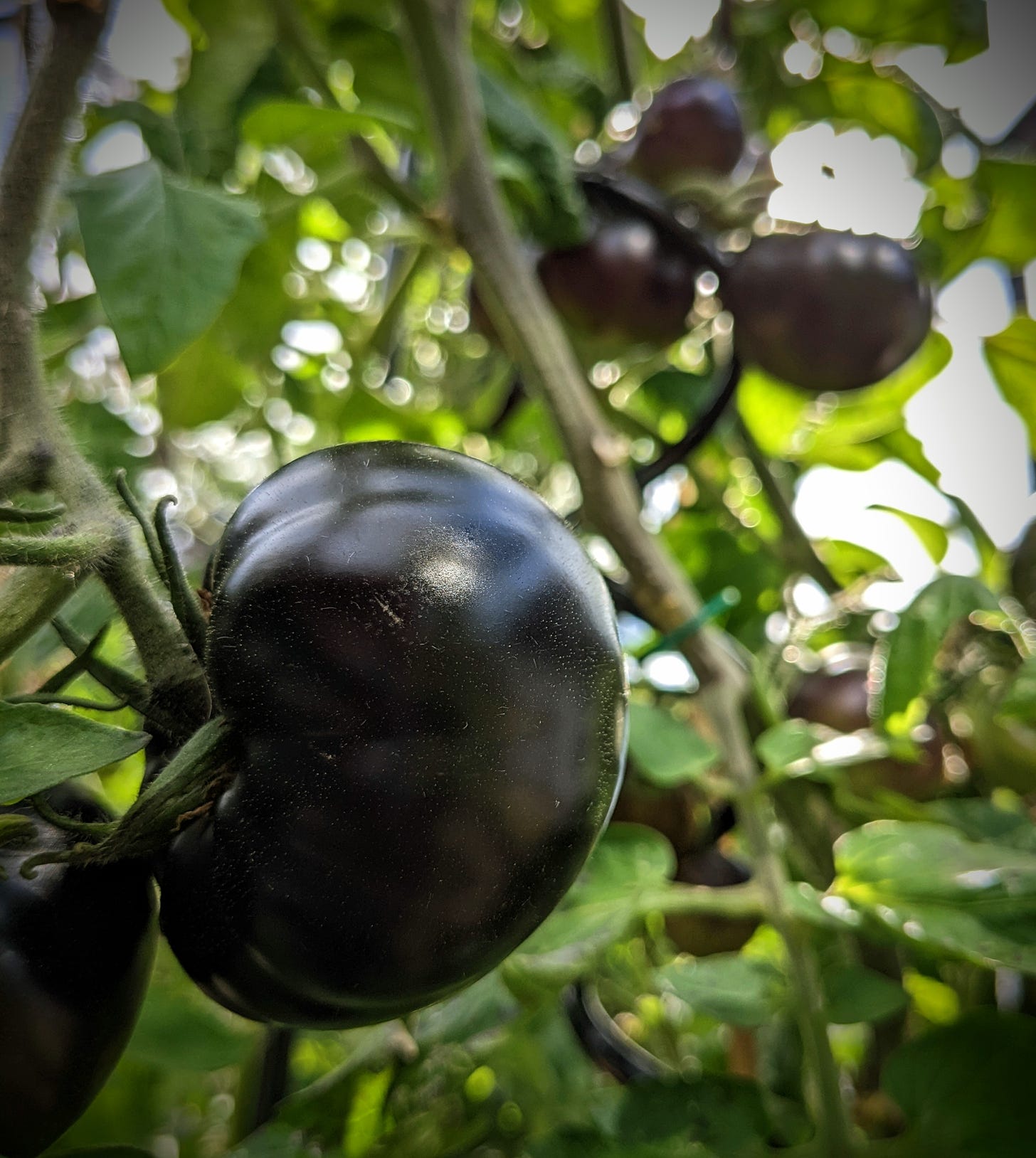
Greenhouse Guest: Justin Davies
This edition, I’m chuffed to invite a dear friend into The Greenhouse – middle grade author Justin Davies!
After years spent flying around the world as cabin crew, Justin finally hung up his wings to focus on writing books that children can lose themselves in. His first book, Help! I Smell a Monster, won the Fantastic Book Awards in 2021. As well as writing, Justin loves visiting schools to share his books, which he says is one of the best things about being a children’s author. When not lost in his own imagination, Justin continues his lifelong quest to bake the perfect scone. It’s an important endeavour, and one he takes very seriously. Justin lives with his husband Andrew, and Sally the rescue greyhound, in the shadow of the Forth Bridge in Fife. You can find Justin on Instagram, Twitter and via his website.
Hi J! Thanks so much for bringing your famous scones. Yum!
We’ve been garden pals for years, swapping seeds and whatnot. So, I know more than a little about what you love to grow. But for the sake of our lovely readers - what’s your favourite plant and why?
I adore hyacinth, for the heady – almost overwhelming – scent, but also for the other-worldly form they take as they reach their peak flowering moment. I enjoy the anticipation as each bulb begins to grow, gradually revealing its flower buds, then gaining height until the flower spike is at its fullest, most bloom-laden, before it can no longer withstand its own glory. I try to support the drooping flower head with canes and string, but it’s a fool’s errand. That’s the thing with hyacinth – their decline is sudden and total. But it was worth it while it lasted.
This year, I’m growing the hyacinth’s smaller cousin, muscari – grape hyacinth – for the first time. There’s something other-worldly about the form the flowers take; grown en-masse in a pot, the effect is of a citadel of spires. They could be my new spring-time obsession.
That’s a great reminder for northern hemisphere folk – there’s still time to plant bulbs, including hyacinths, if you’re quick!
I admit I am bulb *obsessed*. I add, er, many to my collection each year. It means I’m always busy in autumn, planting the promise of flowers for future me. They start blooming in the doldrums of darkest January, reminding me the joy of spring is not far...
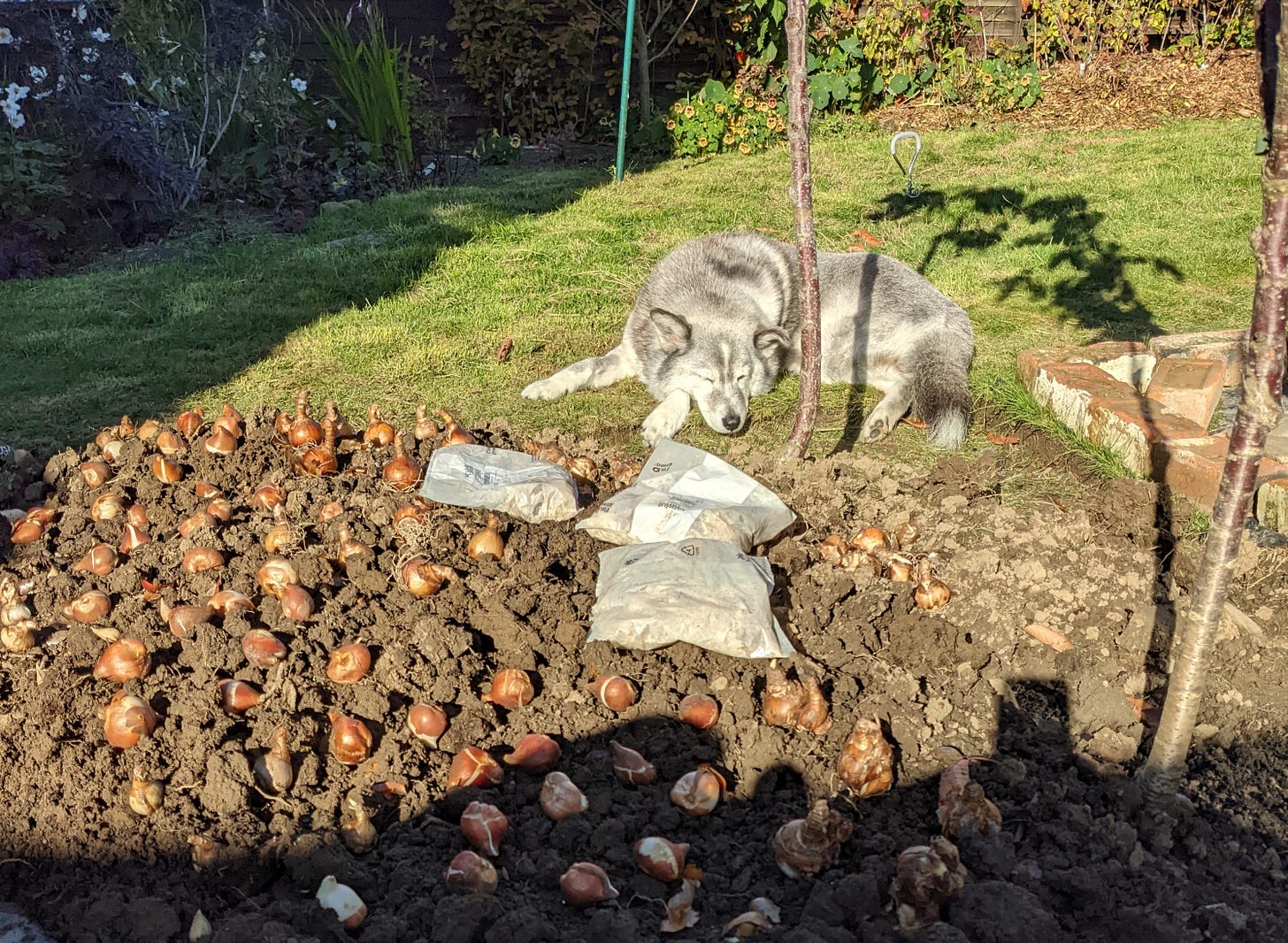
This month, as the days gets darker, I try to keep the memory of seeing the first snowdrop or crocus close to mind. What about you? Do you have any favourite plant memories?
Until the start of the pandemic, I worked as a flight attendant, and in my twenty or so years of flying I was fortunate to have visited many countries. Often, I would push through the jetlag and go in search of a botanic garden, or just find somewhere to walk and enjoy the different plants. Some of my favourite memories of these revitalising visits are: being mesmerised by the incredible orchid collection at the Singapore Botanic Gardens; watching California poppies gently swaying with the warm breeze in sun-drenched beach-side gardens on Los Angeles layovers; driving through the Cape in South Africa and marvelling at the fynbos which covers a vast area of the countryside.
Other memories from further back include spending three months at age 19 in the Dordogne, living in a ramshackle cottage that backed onto a field of sunflowers. It sounds clichéd but I genuinely did throw back the cottage’s old wooden shutters each morning to be greeted by a battalion of proud sunflowers standing to attention for inspection. I hope I appreciated their glory then – I certainly appreciate the memory now.
My most vivid plant-related memory comes from my childhood, when my dad would take me and my sister to pick bluebells every spring in a local wood. There’s a photo of me with a fist-full of blooms; I’m staring into the lens with a melancholy gaze, which I like to think reflects my sadness at how the flowers would wilt within a day having been pulled from the ground.
I love bluebells almost as much as their stable-mates, hyacinth and muscari. One of the thrills of moving to a new house with a garden is waiting and watching for the first twelve months to see what lurks in the soil. When we moved to Scotland, the biggest surprise were the bluebells which appeared in the garden – in an exposed spot with no woodland-like dappled shade. They’ve thrilled every year since, and every year I hold my breath in case they fail to show up – perhaps I’ll know it’s time to move on when they don’t appear.
So, for someone who views bluebells as the fortune tellers of your future home (I mean, I get it!), then I bet there are bunch of other ways plants influence your life. Can we talk about those?
In an alternate life, I think I might have become a horticulturalist. I even remember looking up botany courses when I was applying to university, but went down the modern languages route instead. It’s therefore a bit surprising that plants only began to take on any significant role in my life much later on.
Having said that, I’ve always had a knack for nurturing houseplants, and pride myself on taking in casualties and nursing them back from the brink. A Christmas Cactus lives with us which I grew from a single leaf over thirty years ago – it’s in better shape than ever and this year flowered twice for the first time.
As soon as I had my first garden (a house bought with my husband in rural East Sussex), I began to grow vegetables, learning by trial and error. There was also – joy of joys – a greenhouse, which enabled me to try my hand at tomatoes, cucumbers and, most thrilling of all, chillies. These days I garden in rather more challenging conditions, on the coast of Fife, in an exposed spot, with no greenhouse, at the mercy of chill east winds and salt spray. Undeterred, I’ve embarked on growing what I can in raised beds. It won’t all grow. Along with triumphs, there will be disappointments – which kind of mirrors my writing life.
As well as being an author, I currently work part-time at my local primary school, where I seem to have taken on the role of guardian of the polytunnel. I take groups of children and we sow seeds and learn how to weed and water. Watching a seven-year-old pull up their first radish, and then bite into it and experience a new taste is joyful.
I hope they never tire of the wonder of growing something from seed – I haven’t yet.
I’ve been very lucky to be able to donate some seeds through you for the kids to enjoy. I can’t think of anything more worthwhile than helping children get in touch with the magic of plants. Whenever I visit my young niece, I adore spending time in the backyard with her – she’s such an instinctive and intuitive gardener. I hope she, like you, never loses touch with seeds and soils.
What about in your creative work then? How do plants show up there?
Considering that plants have been part of my life for years, they have only recently featured in my writing. However, in my next book, plants will take on a practical, if not vital, role.
Haarville (publishing with Floris Books, February 2023) is a darkly comic middle grade adventure mystery with a dash of fantasy and the supernatural. It’s a story where the setting drives the narrative and informs much of the lives of the characters. The place they inhabit is totally isolated – everything the townsfolk eat, use and wear must be provided for either from their immediate environment, or from wrecked ships.
Integral to the worldbuilding in this novel is how the villagers make use of the local flora and fauna: flax is used for clothing, rope and paper; wine is produced from hawthorn and rosehip; flour is ground from marsh plantain; sea carrots and parsnips are boiled up for soup; tea is brewed from gutweed and dandelion.
Given the coastal setting, seaweed forms a vital part of the local diet, with bladderwrack and kelp featuring in the form of biscuits, cakes and stews. I wanted the plants in the story to be familiar enough to the reader, but used in unexpected – and perhaps unpalatable – ways to help establish that the setting is very far removed from anything/anywhere they might recognise.
It’s important to the narrative that the community is seen to thrive from this floral bounty, not just survive. Then, when outsiders arrive, their disgust at the food they’re served is at very definite odds to the attitude the locals have to their staple diet, which in turn helps create a climate of fear and mistrust.
I cannot *wait* for Haarville. In the meantime, can you chat about the research process? How did you come up with all of those plant-based worldbuilding touches?
Haarville was almost exclusively written during the first lockdown when there was little or no opportunity to travel. Therefore, I relied on internet research, with “seaweed foraging” to the fore in my search history! The plants that feature in the book are all those that you might expect to find in a Scottish coastal environment – indeed, they are all those that I might find on a short walk from my front door!
I didn’t worry too much about researching which specific plants are used for culinary or practical purposes; instead, I focused on how societies past and present have used plants, then adapted these methods to my novel’s world. It wasn’t important, for example, that marsh plantain root has never been used to make flour, only that it comes across as plausible. If you can make flour by grinding casava root, why not marsh plantain? Similarly, in the world of Haarville, parchment is made from dried seagrass, much as the ancient Egyptians used papyrus.
Now that lockdowns are behind us (and let’s hope it stays that way!), I’ve been able to undertake some last minute, fact-checking research by going on a seaweed foraging workshop which you very kindly joined me on.
I did indeed!
I think you’ll agree that we had an absolute blast trying many different seaweeds fresh off the rocks.
It was fabulous! I learned so much that day.
The workshop leader, Jayson, was amazing. The depth of his foraging knowledge was matched only by his enthusiasm for all things coastal and culinary. Not only did I get the opportunity to ask Jayson if, for example, my characters really ought to be slurping gutweed tea and chowing down on assorted seaweed concoctions without danger of poisoning themselves, but he also cooked up a delicious sea spaghetti lunch for us on the beach.
The highlight of the workshop for me was when Jayson responded to my question about whether limpets are actually edible (in Haarville, they eat limpets by the bucket-load) by promptly knocking one off a nearby rock, hoiking it from its shell and swallowing the meat back in one go. The limpet didn’t know it, but it met its end in the name of accuracy in world building.
With my final edit deadline just a few days afterward, I was able to make some minor adjustments to Haarville based on my newly-gained knowledge, and even add one or two extra seaweed-y details to the story. And as luck would have it, the workshop took place by the fishing village (St Monans in Fife) that was the inspiration for Haarville, so there were plenty of photo and video opportunities on the beach. You now have assorted pieces of footage on your device of me doing silly things with bits of seaweed, which may or may not make an appearance on my social media feeds in the run up to publication! (I expect one or two will make their way into this interview).
Naturally! Here’s you enjoying Jayson’s amazing pesto seaweed spaghetti. Talk about authors committing to worldbuilding research!
Looking to the future then – will plants be featuring in more of your creative projects?
I was going to say that I don’t have plans to do so, but then I realised that there are indeed plants in my current project. My main character’s mum is a self-styled “plant whisperer” who rescues sickly plants and performs mortifyingly embarrassing rituals to save them. My main character finds himself joining hands to form a chanting circle around a poorly cactus, or placing healing stones at the roots of a wilting peace lily. There’s even a giant Venus Fly Trap called Lawrence (this is funny lower middle grade territory!) who is poisoned by a fizzy gummy bear and requires a drip infusion of concentrated worm juice. I’ve gone from using plants for world-building to deploying them for comedic effect.
Delightful!
Now, we’ve scoffed our scones, and the teapot is empty. Before we go, do you have any recommended reads featuring plants?
My sister bought me a subscription to Queer Book Box (curated by Gays the Word bookshop in London) and one of my favourite books to arrive has been This Poison Heart by Kalynn Bayron (Bloomsbury). The main character, Briseis, has the magical power to make flowers bloom or come back to life from a single touch. It’s a story about the beauty of plants, and how they can be used for healing, but also about the darker side of plant lore and their ability to poison and kill. There you have it. Plants can be all these things: beautiful, magical, healing… and deadly. The more I learn about plants and what they can be and do, the more fascinated I become.
Oooh, I’ve bumped this up my TBR. Can’t wait!
That’s all for this edition, folks! For those of you in the northern hemisphere, a reminder to pop some bulbs in a pot or any ground you have access to – your spring self will thank you.
You know what else you can gift to your future self? A pre-order or library request for a spring-release book. Maybe even a copy of the glorious Haarville by one Justin Davies, out in Feb!
Until next time…




